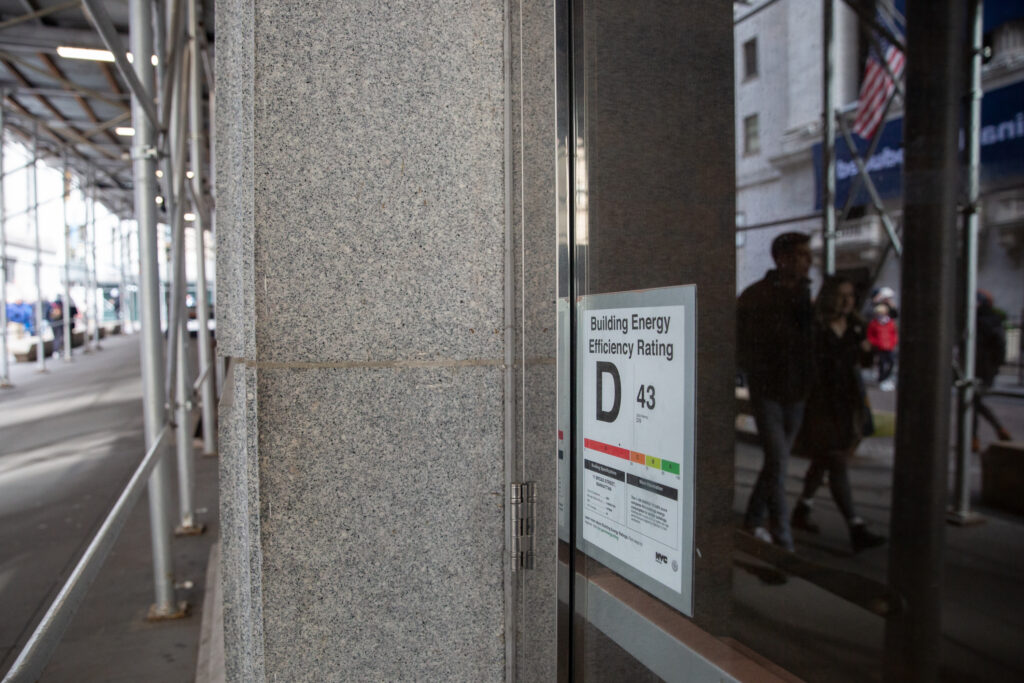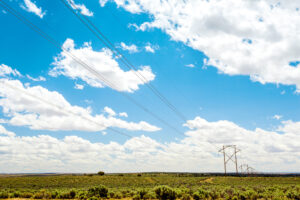Nearly Half of NYC Buildings Fail to Make the Green Grade

New York buildings are slowly becoming more energy efficient — but with nearly half earning Ds or Fs on city report cards, many are still struggling to make the grade.
That’s the conclusion of THE CITY’s analysis of preliminary data obtained from the city Department of Buildings, offering a glimpse into the grading system’s second year — even as the pandemic skews typical energy usage patterns.
Across the city, nearly 20% of buildings 25,000 square feet or larger received A grades, compared with about 16% in 2020, the data shows.
Like last year, lackluster Ds proved the most popular grade, though the share fell from 44% in 2020 to about 39% this year. And over 9% of buildings — up from about 7.5% last year — earned Fs, meaning the building owner failed to submit data to the city.
Overall, more than 20,000 buildings — from pre-war apartment complexes to skyscrapers — were graded. Poor grades carry no penalties, but failing to post the letter marks could mean a $1,250 fine.
Environment boosters saw reason for hope in the latest collective report card.
“Building owners care so much. We’ve never seen anything have as high an impact,” said Donnel Baird, CEO of the company Blocpower, which upgrades buildings for improved energy efficiency, mainly through electrification. “Even the threat of fines has not created as much of a reaction as these letter grades on the front of the buildings.”
On a per-borough basis, Manhattan’s building stock had the largest share of As compared to all its grades: 23%, up from almost 15% in 2020, when the borough came in third behind Brooklyn and Queens.
Gina Bocra, DOB’s chief sustainability officer, attributes the overall improvement to the visibility of the energy efficiency information, which motivates property owners to do better.
“Owners have been acting on that information, so the transparency is working, and we’re getting them to be more familiar with what’s happening in their building,” Bocra said. “They’re beginning to make alterations to the building to change what’s happening there.”
The grades and the focus on energy efficiency are part of the city’s effort to slash greenhouse gas emissions from buildings — the city’s largest source of emissions — 40% from 2005 levels by 2030 and 80% by 2050 in the race to mitigate climate change.
Efficiency as a Marketing Draw
Oct. 31 marked the deadline for the second time building owners were required to post grades for all tenants, customers and passers-by to see.
The building grade law applied the concept of restaurant grades, which indicate food safety, to energy efficiency in an effort to spark greater awareness of energy consumption — and, in theory, compel change.
For over a decade, building owners have been required to tally their water and energy consumption data each year and submit the information to the city. Emissions from more than 3,000 properties required to measure usage fell almost 23% between 2010 and 2019, and energy use dropped nearly 9% in that timespan, according to the Urban Green Council.
The 2019 law establishing the public grades attempted to push the concept further. The grades themselves are based on the energy usage data and a score, ranging from 1 to 100, indicating how efficient the building is compared to similar structures across the country.
This federal ENERGY STAR score is the basis for the grade, with an A equal to a score of 85 or above, and a D equal to a score between 0 and 54.
The DOB will adjust the grading scale over time as buildings improve, Bocra said.
Posting the grade where potential renters, homebuyers and commercial tenants can see it was supposed to spur action on the part of eco-conscious building owners who want to ace the efficiency test and attract customers in a hot real estate market.
Across the city, buildings improved by three points on average in 2021 compared to 2020, with 2020’s average score of 54 rising to 57 this year, according to THE CITY’s analysis.
Almost a third of buildings improved between one and nine points. In all, 56% of buildings bolstered their scores from one year to the next, while about 35% saw their scores fall.
Pandemic Grading Curve
Some buildings took big jumps.
The multi-family building at 2017 Amsterdam Ave. in Washington Heights went from a D to an A between 2020 and 2021 — one of five buildings that scored 99 points higher from one year to the next, according to THE CITY’s analysis.
Avi Khatri, a property manager for Chatam Management Company who oversees the building, chalks up the improvement to a series of upgrades made in late 2019 and early 2020. Among them: installing LED lights, insulating steam pipes and switching the boiler from oil to gas.
“We wanted to make sure we were running efficiently, but we really didn’t look much about that,” he said, referring to the grades. “Our goal is to be as energy efficient as possible.”
He wasn’t sure how much all the changes cost, but said it was expensive for the landlord. At the same time, he noted cost savings: the LED lights last longer than incandescent bulbs and the energy bill was cut in half.
Since the grades indicate energy use in the previous year — so a 2021 grade shows the building’s efficiency in 2020 — it’s clear the building upgrades had an effect, even with the more than 60 tenants home during the pandemic.
Aron Parnes, director of operations at the efficiency consulting firm IAG Energy, observed that the pandemic lockdown resulted in improvements in office and commercial spaces, which sat largely empty and saw less energy use.
Still, a report from the Institute for Market Transformation showed only 5% of office buildings saw energy reductions of more than 30%. On the flip side, residential properties, filled with people at all hours of the day, logged more energy use.
“It’s not like you can get an understanding of energy trends by looking at 2020,” Parnes said.
‘Just an Anomaly’
An exception to Parnes’ observation about residential properties’ energy use is the Kips Bay residential building at 303 E. 33rd St., which houses both condos and rental apartments. It boosted its D grade in 2020 to a B in 2021.
“That was just an anomaly. Because of the pandemic, the amenities weren’t being used, and most of the unit owners were at their secondary homes,” said Cynthia Allan, an account executive at Century Management, the property manager.
Although 303 E. 33rd St. is decades newer than 2017 Amsterdam Ave. and boasts a Leadership in Energy and Environmental Design, or LEED, certification, it is less efficient, according to the grading system.
Buildings considered LEED-certified incorporate construction, operation, performance and design elements that are “green.” But some of those elements, such as bike storage, on-site showers and using recycled materials, won’t affect the building’s energy efficiency.
The latest grade shows that 303 E. 33rd St. is more efficient than more than 83% of similar buildings around the country. But as residents move back in, the building may once again drop to its pre-pandemic score, which showed it was only more efficient than 47% of similar buildings nationwide.
The difference in grades for buildings like that show that ENERGY STAR scores don’t translate as easily to buildings — with their varied occupation densities — as they do for appliances like dishwashers, according to Jordan Barowitz, vice president of public affairs at the Durst Organization.
“The ratings are worse than useless: They are misleading,” he said, adding that the grades have not prompted any concerns or inquiries from commercial or residential tenants.
Landlord Investment Needed
Given the range of scores for each grade, the large jumps required to move from one level to another means “the system offers little incentive to improve your grade,” Barowitz said.
Parnes of IAG Energy sees that issue come up when his company makes recommendations for what can be done to improve a grade: replacing an old boiler, converting gas appliances to electric, switching gas boilers for heat pumps, sealing the doors, installing solar, using double panes in windows and developing on-site solar.
“The problem is that there are lower ticket items like upgrading the lighting or insulating all the pipes…. They help a lot, but they’re not bringing you up from a 20 grade [a D] to an 85 [a B],” Parnes said.
Still, grades have added pressure for some building owners who seek out the help of companies that do energy auditing like Parnes’. He said he’s observed differences in how his clients approach efficiency based on their buildings’ location and clientele.
In upscale neighborhoods, property owners of doorman buildings especially want As, he said. And some of his commercial clients have indicated that their tenants, such as corporations that tout green initiatives, have shown reticence to lease office space in a building with a low grade.
Fines on the Way
Many of the same retrofits that make a building more efficient can also help slash carbon emissions.
Under Local Law 97, building owners may incur fines starting in 2024 if the buildings don’t comply with emissions targets.
John Mandyck, CEO of the Urban Green Council, said grades more or less indicate how well a building will do under Local Law 97, with higher grades roughly corresponding with lower carbon intensities.
“But it’s not an exact barometer because the focus of regulatory measurement changed from energy to carbon after the letter grades were passed,” Mandyck said. “Energy efficiency is a component of how you get to carbon savings.”
Jenna Tatum, director of the Building Electrification Institute and a former policy advisor in the Mayor’s Office of Sustainability, said Local Law 97 “will primarily result in energy efficiency.”
Still, she said, to combat climate change, the regulatory focus will need to be on requiring buildings to convert fossil fuel-powered systems to electric in order to achieve net-zero emissions.
‘It’s Not Easy’
An obstacle to better grades that property owners can’t control is how much energy tenants use — they may leave the lights on or blast their air conditioning units even when they’re not home, driving down the building’s energy performance.
While Con Ed and National Grid both provide financial incentives for customers to use less energy, it’s largely up to building owners to make improvements.
“We are doing as much as possible, and it’s not easy,” said Khatri. He said he wants to replace the current windows with more efficient models and make other changes — and wants more help from the city.
The city’s “NYC Accelerator” offers guidance and access to resources — financial and otherwise — to make buildings greener.
So do the utility companies: National Grid also offers energy assessments and recommendations for building owners to improve their properties’ energy performance in compliance with city laws. Con Ed provides rebates for efficiency improvements for property owners.
The utility company paid $14.8 million in cash incentives to multi-family customers in 1,500 buildings in 2020. That year, Con Ed also helped install nearly 9,000 heat pumps and five million LED light bulbs in homes.
Kelly Westby, director of building operations at the consulting firm Steven Winter Associates, said the letter grades have prompted scrutiny of energy efficiency practices at a time when taking action for the environment is essential.
“If your kid comes back with a bad grade on their report card, do you go around kicking and screaming about the grading system or, maybe worse, just ignore it?” she said. “Maybe some parents do, but I think you take the time to look into it.”
This article was originally posted on Nearly Half of NYC Buildings Fail to Make the Green Grade







